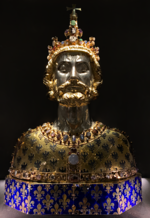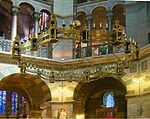Aachen Cathedral

Aachen Cathedral (German: Aachener Dom) is a Roman Catholic church in Aachen, Germany and the seat of the Roman Catholic Diocese of Aachen. One of the oldest cathedrals in Europe, it was constructed by order of Emperor Charlemagne, who was buried there in 814. From 936 to 1531, the Palatine Chapel saw the coronation of thirty-one German kings and twelve queens. The church has been the mother church of the Diocese of Aachen since 1930. In 1978, Aachen Cathedral was one of the first 12 items to be listed on the UNESCO list of World Heritage sites, because of its exceptional artistry, architecture, and central importance in the history of the Holy Roman Empire.
Excerpt from the Wikipedia article Aachen Cathedral (License: CC BY-SA 3.0, Authors, Images).Aachen Cathedral
Domhof, Aachen Burtscheid (Aachen-Mitte)
Geographical coordinates (GPS) Address Phone number Website External links Nearby Places Show on map
Geographical coordinates (GPS)
| Latitude | Longitude |
|---|---|
| N 50.77475 ° | E 6.0839222222222 ° |
Address
Aachener Dom
Domhof 1
52062 Aachen, Burtscheid (Aachen-Mitte)
North Rhine-Westphalia, Germany
Open on Google Maps









